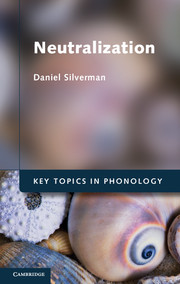Book contents
- Frontmatter
- Contents
- List of Figures
- Preface
- Acknowledgments
- 1 The rhyme and the reason of neutralization
- Part I Rhyme
- Section A Observation and description
- Section B False positives
- Section C Explanation
- 7 Ease of production
- 8 Ease of perception
- 9 Phonetic misperception
- 10 Semantic misperception: early proposals
- 11 Semantic misperception: recent proposals
- Section D Exemplification
- Part II Reason
- Glossary
- References
- Language index
- Subject index
8 - Ease of perception
Published online by Cambridge University Press: 05 November 2012
- Frontmatter
- Contents
- List of Figures
- Preface
- Acknowledgments
- 1 The rhyme and the reason of neutralization
- Part I Rhyme
- Section A Observation and description
- Section B False positives
- Section C Explanation
- 7 Ease of production
- 8 Ease of perception
- 9 Phonetic misperception
- 10 Semantic misperception: early proposals
- 11 Semantic misperception: recent proposals
- Section D Exemplification
- Part II Reason
- Glossary
- References
- Language index
- Subject index
Summary
As discussed in Chapter 7, at first blush, it might seem perfectly reasonable to assume that linguistic structure is influenced at least in part by speakers looking to (presumably unconsciously) ease their own articulatory burden. Just as quickly, however, such a hypothesis encountered insurmountable difficulties, and we concluded that “ease-of-articulation” influences on linguistic sound structure are at the very least several times removed from the world of individual speakers.
There are, however, variations on the fatally flawed theme of speaker-controlled approaches to sound patterning in general – and neutralization in particular – that we turn to now. These approaches center on the hypothesis that speakers control their speech in order to ease the perceptual burden of their interlocutors. We consider, in turn, Lindblom's “H&H hypothesis”, Jun's “production hypothesis”, and Steriade's “P-map hypothesis”. We conclude by discussing some outstanding issues that arise from these accounts.
LINDBLOM’S H&H HYPOTHESIS (1990)
Lindblom (1990) does not specifically address the issue of neutralization. Nonetheless, as we shall see, his “H&H” (hyper- and hypo-articulation) proposal readily lends itself to such an application. The underlying assumption of this speaker-oriented approach to speech organization is that language users have an awareness of listeners’ ability to extract information fromthe speech signal. Consequently, speakers adjust their speech such that it varies along a hypo-articulation–hyper-articulation continuum. Hypo-articulation involves a “default to some low-cost form of behavior”. If speech sounds are hypo-articulated up to or surpassing the point of their unique discriminability, neutralization may result. Hyper-articulation involves a higher-cost form of behavior in which speech gestures are greater in magnitude and/or duration, thus enhancing the ease with which listeners recover information, perhaps especially in contexts in which non-hyper-articulated speech sounds would run the risk of non-recoverability. In short: (1) speakers are constrained by certain production limitations that are both physiological and cognitive in origin; and (2) speakers are aware of the receptive constraints of listeners, which are social and communicative in origin. Thus, overall, his model is certainly speaker-oriented, but speakers nonetheless take listening constraints into consideration as they plan and implement their speech.
- Type
- Chapter
- Information
- Neutralization , pp. 86 - 100Publisher: Cambridge University PressPrint publication year: 2012



